Employee's Expectation and Job Performance in Private Sector Research
VerifiedAdded on 2023/04/20
|73
|19544
|438
Project
AI Summary
This master's thesis, conducted by Lee Pey Fung at the Faculty of Cognitive Sciences and Human Development, explores the relationship between employee expectations and job performance in the Malaysian private sector. The research investigates how factors such as remuneration, work environment, and organizational culture influence employee outcomes. The study employs a mixed-methods approach, including literature review, survey, and statistical analysis to examine the impact of employee expectations on job performance. The findings highlight the significance of aligning employee expectations with organizational practices to enhance job performance and overall organizational success. The research also provides implications for human resource practitioners and organizations to improve employee satisfaction and productivity. The study concludes with recommendations for future research and practical applications to foster a positive work environment and achieve organizational goals.

Faculty of Cognitive Sciences And Human Development
Employee’s Expectation and Its Relationship with Job Performance
In Private Sector
Name: Lee Pey Fung
Matric No: 16030510
Supervisor : Assoc. Prof. Dr. Shahren Ahmad Zaidi Adruce
Master of Science
(Human Resource Development)
2018
Employee’s Expectation and Its Relationship with Job Performance
In Private Sector
Name: Lee Pey Fung
Matric No: 16030510
Supervisor : Assoc. Prof. Dr. Shahren Ahmad Zaidi Adruce
Master of Science
(Human Resource Development)
2018
Paraphrase This Document
Need a fresh take? Get an instant paraphrase of this document with our AI Paraphraser
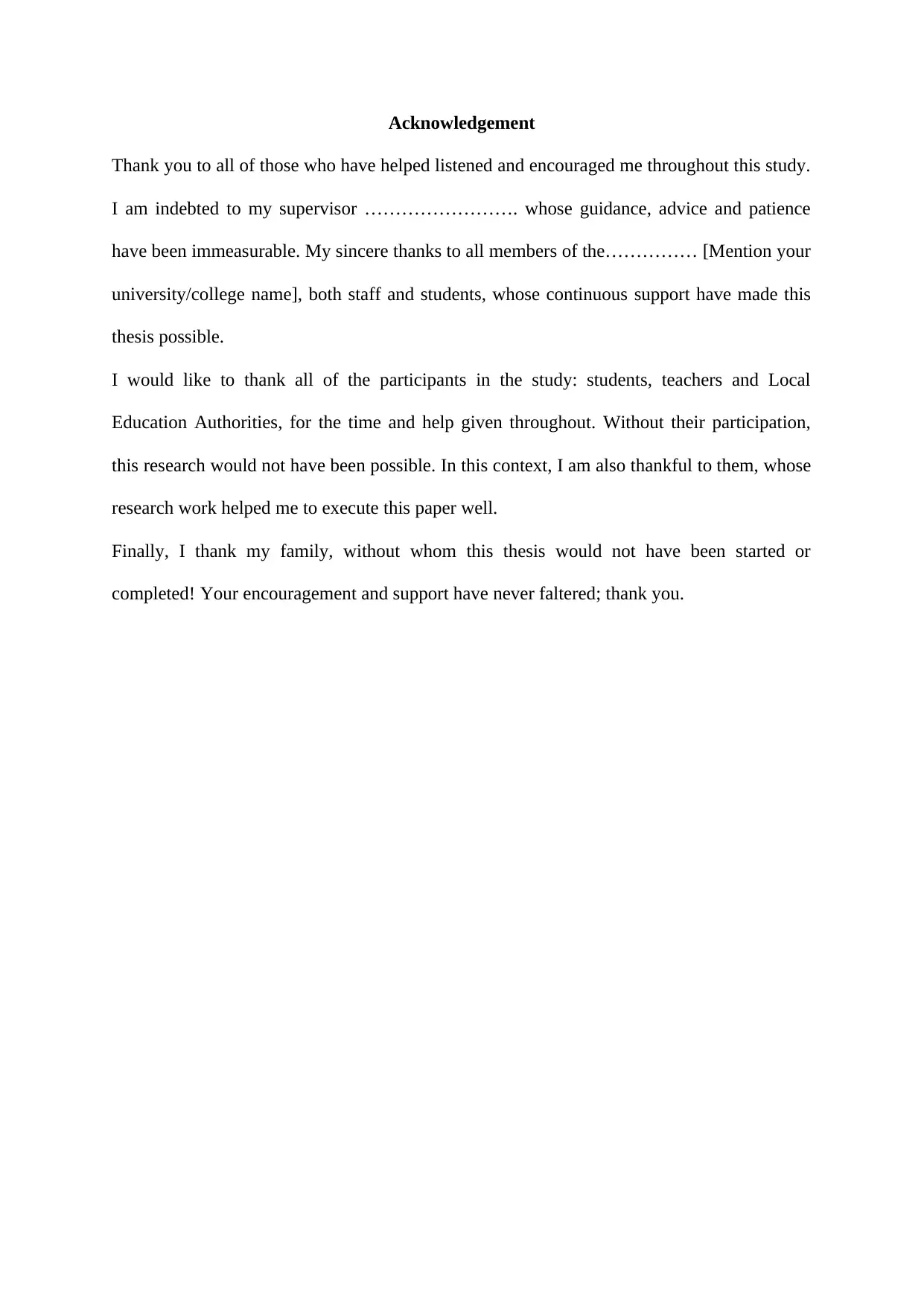
Acknowledgement
Thank you to all of those who have helped listened and encouraged me throughout this study.
I am indebted to my supervisor ……………………. whose guidance, advice and patience
have been immeasurable. My sincere thanks to all members of the…………… [Mention your
university/college name], both staff and students, whose continuous support have made this
thesis possible.
I would like to thank all of the participants in the study: students, teachers and Local
Education Authorities, for the time and help given throughout. Without their participation,
this research would not have been possible. In this context, I am also thankful to them, whose
research work helped me to execute this paper well.
Finally, I thank my family, without whom this thesis would not have been started or
completed! Your encouragement and support have never faltered; thank you.
Thank you to all of those who have helped listened and encouraged me throughout this study.
I am indebted to my supervisor ……………………. whose guidance, advice and patience
have been immeasurable. My sincere thanks to all members of the…………… [Mention your
university/college name], both staff and students, whose continuous support have made this
thesis possible.
I would like to thank all of the participants in the study: students, teachers and Local
Education Authorities, for the time and help given throughout. Without their participation,
this research would not have been possible. In this context, I am also thankful to them, whose
research work helped me to execute this paper well.
Finally, I thank my family, without whom this thesis would not have been started or
completed! Your encouragement and support have never faltered; thank you.
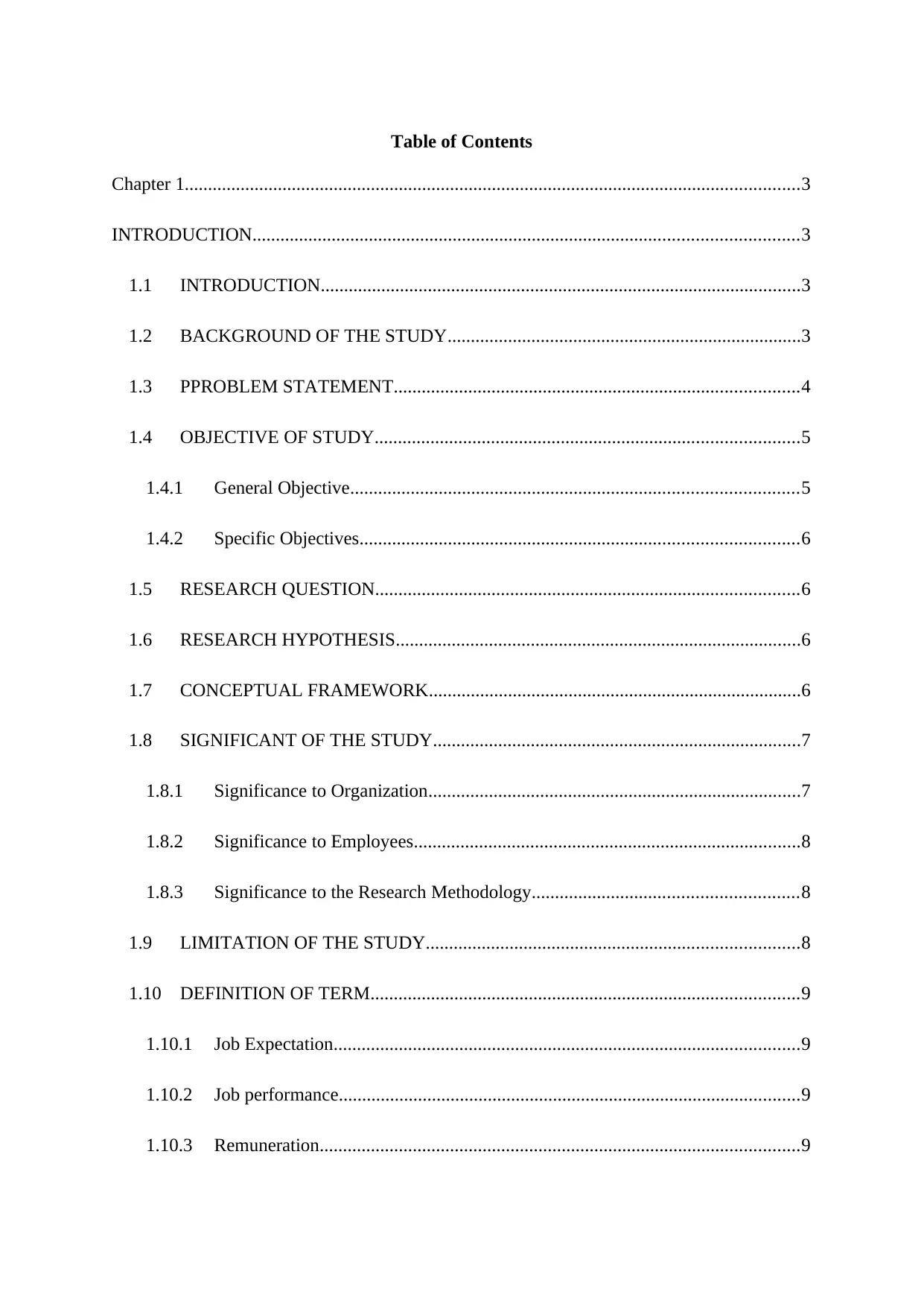
Table of Contents
Chapter 1....................................................................................................................................3
INTRODUCTION.....................................................................................................................3
1.1 INTRODUCTION.......................................................................................................3
1.2 BACKGROUND OF THE STUDY............................................................................3
1.3 PPROBLEM STATEMENT.......................................................................................4
1.4 OBJECTIVE OF STUDY...........................................................................................5
1.4.1 General Objective................................................................................................5
1.4.2 Specific Objectives..............................................................................................6
1.5 RESEARCH QUESTION...........................................................................................6
1.6 RESEARCH HYPOTHESIS.......................................................................................6
1.7 CONCEPTUAL FRAMEWORK................................................................................6
1.8 SIGNIFICANT OF THE STUDY...............................................................................7
1.8.1 Significance to Organization................................................................................7
1.8.2 Significance to Employees...................................................................................8
1.8.3 Significance to the Research Methodology.........................................................8
1.9 LIMITATION OF THE STUDY................................................................................8
1.10 DEFINITION OF TERM............................................................................................9
1.10.1 Job Expectation....................................................................................................9
1.10.2 Job performance...................................................................................................9
1.10.3 Remuneration.......................................................................................................9
Chapter 1....................................................................................................................................3
INTRODUCTION.....................................................................................................................3
1.1 INTRODUCTION.......................................................................................................3
1.2 BACKGROUND OF THE STUDY............................................................................3
1.3 PPROBLEM STATEMENT.......................................................................................4
1.4 OBJECTIVE OF STUDY...........................................................................................5
1.4.1 General Objective................................................................................................5
1.4.2 Specific Objectives..............................................................................................6
1.5 RESEARCH QUESTION...........................................................................................6
1.6 RESEARCH HYPOTHESIS.......................................................................................6
1.7 CONCEPTUAL FRAMEWORK................................................................................6
1.8 SIGNIFICANT OF THE STUDY...............................................................................7
1.8.1 Significance to Organization................................................................................7
1.8.2 Significance to Employees...................................................................................8
1.8.3 Significance to the Research Methodology.........................................................8
1.9 LIMITATION OF THE STUDY................................................................................8
1.10 DEFINITION OF TERM............................................................................................9
1.10.1 Job Expectation....................................................................................................9
1.10.2 Job performance...................................................................................................9
1.10.3 Remuneration.......................................................................................................9
⊘ This is a preview!⊘
Do you want full access?
Subscribe today to unlock all pages.

Trusted by 1+ million students worldwide
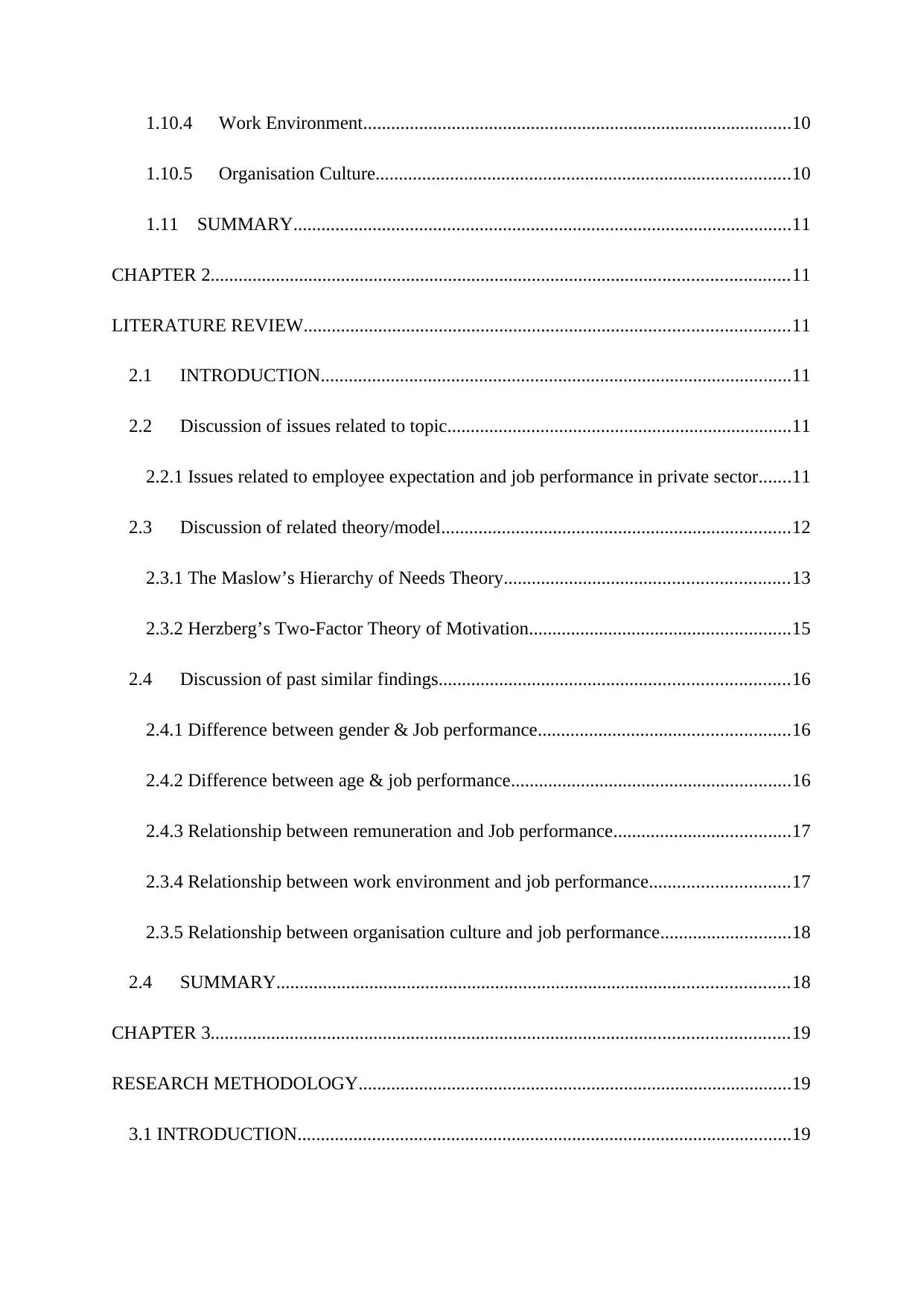
1.10.4 Work Environment............................................................................................10
1.10.5 Organisation Culture.........................................................................................10
1.11 SUMMARY...........................................................................................................11
CHAPTER 2............................................................................................................................11
LITERATURE REVIEW........................................................................................................11
2.1 INTRODUCTION.....................................................................................................11
2.2 Discussion of issues related to topic..........................................................................11
2.2.1 Issues related to employee expectation and job performance in private sector.......11
2.3 Discussion of related theory/model...........................................................................12
2.3.1 The Maslow’s Hierarchy of Needs Theory.............................................................13
2.3.2 Herzberg’s Two-Factor Theory of Motivation........................................................15
2.4 Discussion of past similar findings...........................................................................16
2.4.1 Difference between gender & Job performance......................................................16
2.4.2 Difference between age & job performance............................................................16
2.4.3 Relationship between remuneration and Job performance......................................17
2.3.4 Relationship between work environment and job performance..............................17
2.3.5 Relationship between organisation culture and job performance............................18
2.4 SUMMARY..............................................................................................................18
CHAPTER 3............................................................................................................................19
RESEARCH METHODOLOGY.............................................................................................19
3.1 INTRODUCTION..........................................................................................................19
1.10.5 Organisation Culture.........................................................................................10
1.11 SUMMARY...........................................................................................................11
CHAPTER 2............................................................................................................................11
LITERATURE REVIEW........................................................................................................11
2.1 INTRODUCTION.....................................................................................................11
2.2 Discussion of issues related to topic..........................................................................11
2.2.1 Issues related to employee expectation and job performance in private sector.......11
2.3 Discussion of related theory/model...........................................................................12
2.3.1 The Maslow’s Hierarchy of Needs Theory.............................................................13
2.3.2 Herzberg’s Two-Factor Theory of Motivation........................................................15
2.4 Discussion of past similar findings...........................................................................16
2.4.1 Difference between gender & Job performance......................................................16
2.4.2 Difference between age & job performance............................................................16
2.4.3 Relationship between remuneration and Job performance......................................17
2.3.4 Relationship between work environment and job performance..............................17
2.3.5 Relationship between organisation culture and job performance............................18
2.4 SUMMARY..............................................................................................................18
CHAPTER 3............................................................................................................................19
RESEARCH METHODOLOGY.............................................................................................19
3.1 INTRODUCTION..........................................................................................................19
Paraphrase This Document
Need a fresh take? Get an instant paraphrase of this document with our AI Paraphraser
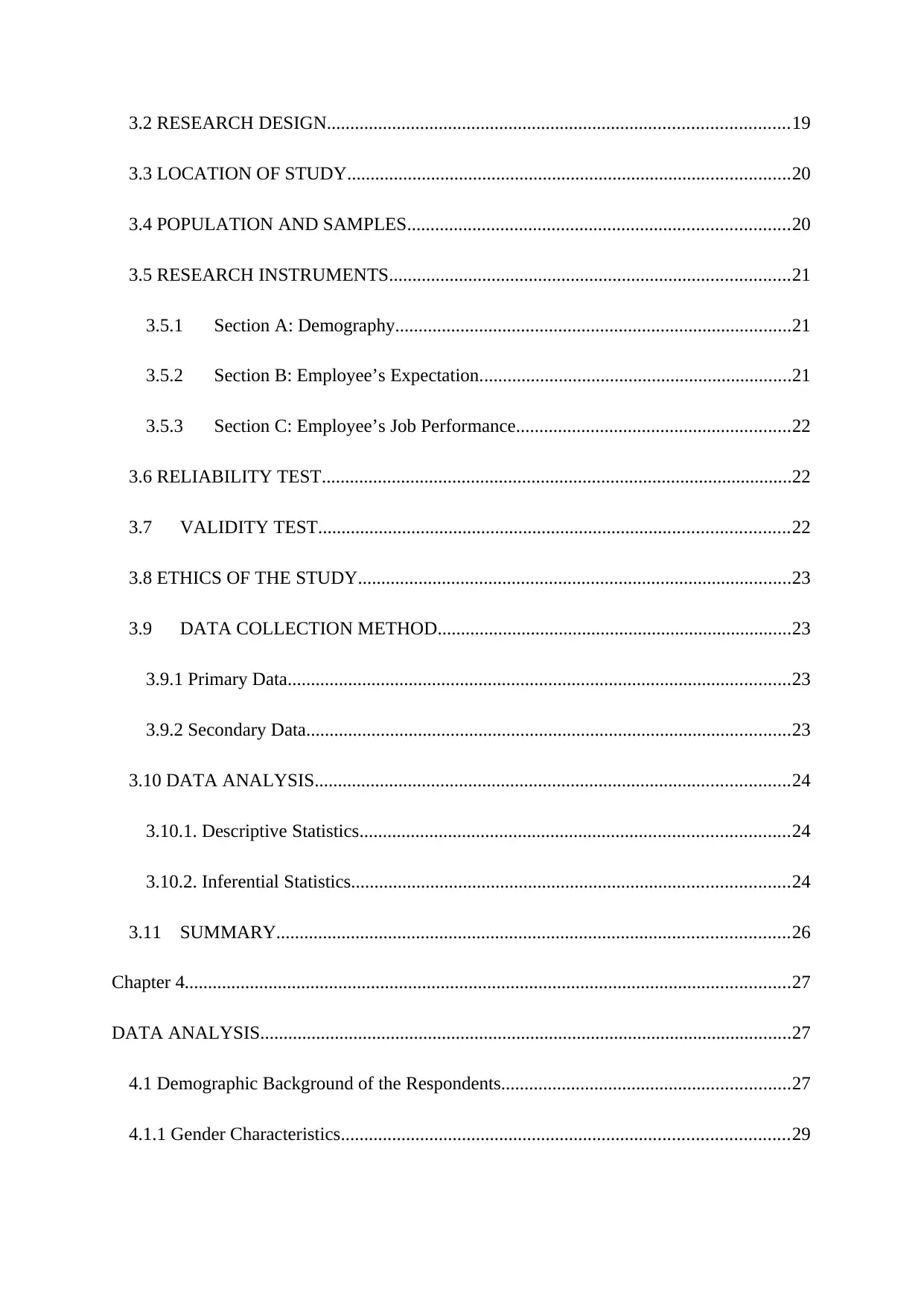
3.2 RESEARCH DESIGN...................................................................................................19
3.3 LOCATION OF STUDY...............................................................................................20
3.4 POPULATION AND SAMPLES..................................................................................20
3.5 RESEARCH INSTRUMENTS......................................................................................21
3.5.1 Section A: Demography.....................................................................................21
3.5.2 Section B: Employee’s Expectation...................................................................21
3.5.3 Section C: Employee’s Job Performance...........................................................22
3.6 RELIABILITY TEST.....................................................................................................22
3.7 VALIDITY TEST.....................................................................................................22
3.8 ETHICS OF THE STUDY.............................................................................................23
3.9 DATA COLLECTION METHOD............................................................................23
3.9.1 Primary Data............................................................................................................23
3.9.2 Secondary Data........................................................................................................23
3.10 DATA ANALYSIS......................................................................................................24
3.10.1. Descriptive Statistics............................................................................................24
3.10.2. Inferential Statistics..............................................................................................24
3.11 SUMMARY..............................................................................................................26
Chapter 4..................................................................................................................................27
DATA ANALYSIS..................................................................................................................27
4.1 Demographic Background of the Respondents..............................................................27
4.1.1 Gender Characteristics................................................................................................29
3.3 LOCATION OF STUDY...............................................................................................20
3.4 POPULATION AND SAMPLES..................................................................................20
3.5 RESEARCH INSTRUMENTS......................................................................................21
3.5.1 Section A: Demography.....................................................................................21
3.5.2 Section B: Employee’s Expectation...................................................................21
3.5.3 Section C: Employee’s Job Performance...........................................................22
3.6 RELIABILITY TEST.....................................................................................................22
3.7 VALIDITY TEST.....................................................................................................22
3.8 ETHICS OF THE STUDY.............................................................................................23
3.9 DATA COLLECTION METHOD............................................................................23
3.9.1 Primary Data............................................................................................................23
3.9.2 Secondary Data........................................................................................................23
3.10 DATA ANALYSIS......................................................................................................24
3.10.1. Descriptive Statistics............................................................................................24
3.10.2. Inferential Statistics..............................................................................................24
3.11 SUMMARY..............................................................................................................26
Chapter 4..................................................................................................................................27
DATA ANALYSIS..................................................................................................................27
4.1 Demographic Background of the Respondents..............................................................27
4.1.1 Gender Characteristics................................................................................................29
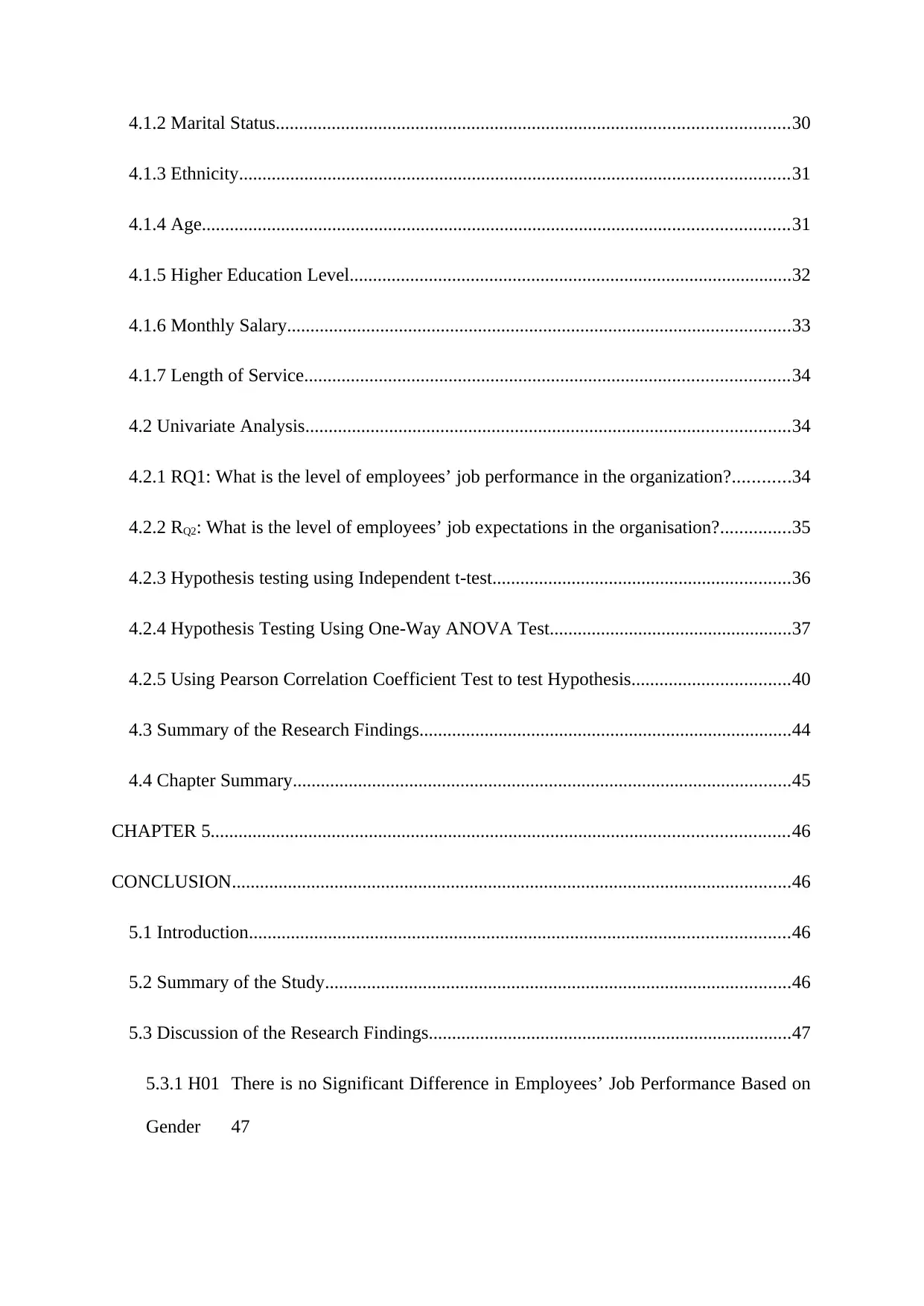
4.1.2 Marital Status..............................................................................................................30
4.1.3 Ethnicity......................................................................................................................31
4.1.4 Age..............................................................................................................................31
4.1.5 Higher Education Level...............................................................................................32
4.1.6 Monthly Salary............................................................................................................33
4.1.7 Length of Service........................................................................................................34
4.2 Univariate Analysis........................................................................................................34
4.2.1 RQ1: What is the level of employees’ job performance in the organization?............34
4.2.2 RQ2: What is the level of employees’ job expectations in the organisation?...............35
4.2.3 Hypothesis testing using Independent t-test................................................................36
4.2.4 Hypothesis Testing Using One-Way ANOVA Test....................................................37
4.2.5 Using Pearson Correlation Coefficient Test to test Hypothesis..................................40
4.3 Summary of the Research Findings................................................................................44
4.4 Chapter Summary...........................................................................................................45
CHAPTER 5............................................................................................................................46
CONCLUSION........................................................................................................................46
5.1 Introduction....................................................................................................................46
5.2 Summary of the Study....................................................................................................46
5.3 Discussion of the Research Findings..............................................................................47
5.3.1 H01 There is no Significant Difference in Employees’ Job Performance Based on
Gender 47
4.1.3 Ethnicity......................................................................................................................31
4.1.4 Age..............................................................................................................................31
4.1.5 Higher Education Level...............................................................................................32
4.1.6 Monthly Salary............................................................................................................33
4.1.7 Length of Service........................................................................................................34
4.2 Univariate Analysis........................................................................................................34
4.2.1 RQ1: What is the level of employees’ job performance in the organization?............34
4.2.2 RQ2: What is the level of employees’ job expectations in the organisation?...............35
4.2.3 Hypothesis testing using Independent t-test................................................................36
4.2.4 Hypothesis Testing Using One-Way ANOVA Test....................................................37
4.2.5 Using Pearson Correlation Coefficient Test to test Hypothesis..................................40
4.3 Summary of the Research Findings................................................................................44
4.4 Chapter Summary...........................................................................................................45
CHAPTER 5............................................................................................................................46
CONCLUSION........................................................................................................................46
5.1 Introduction....................................................................................................................46
5.2 Summary of the Study....................................................................................................46
5.3 Discussion of the Research Findings..............................................................................47
5.3.1 H01 There is no Significant Difference in Employees’ Job Performance Based on
Gender 47
⊘ This is a preview!⊘
Do you want full access?
Subscribe today to unlock all pages.

Trusted by 1+ million students worldwide
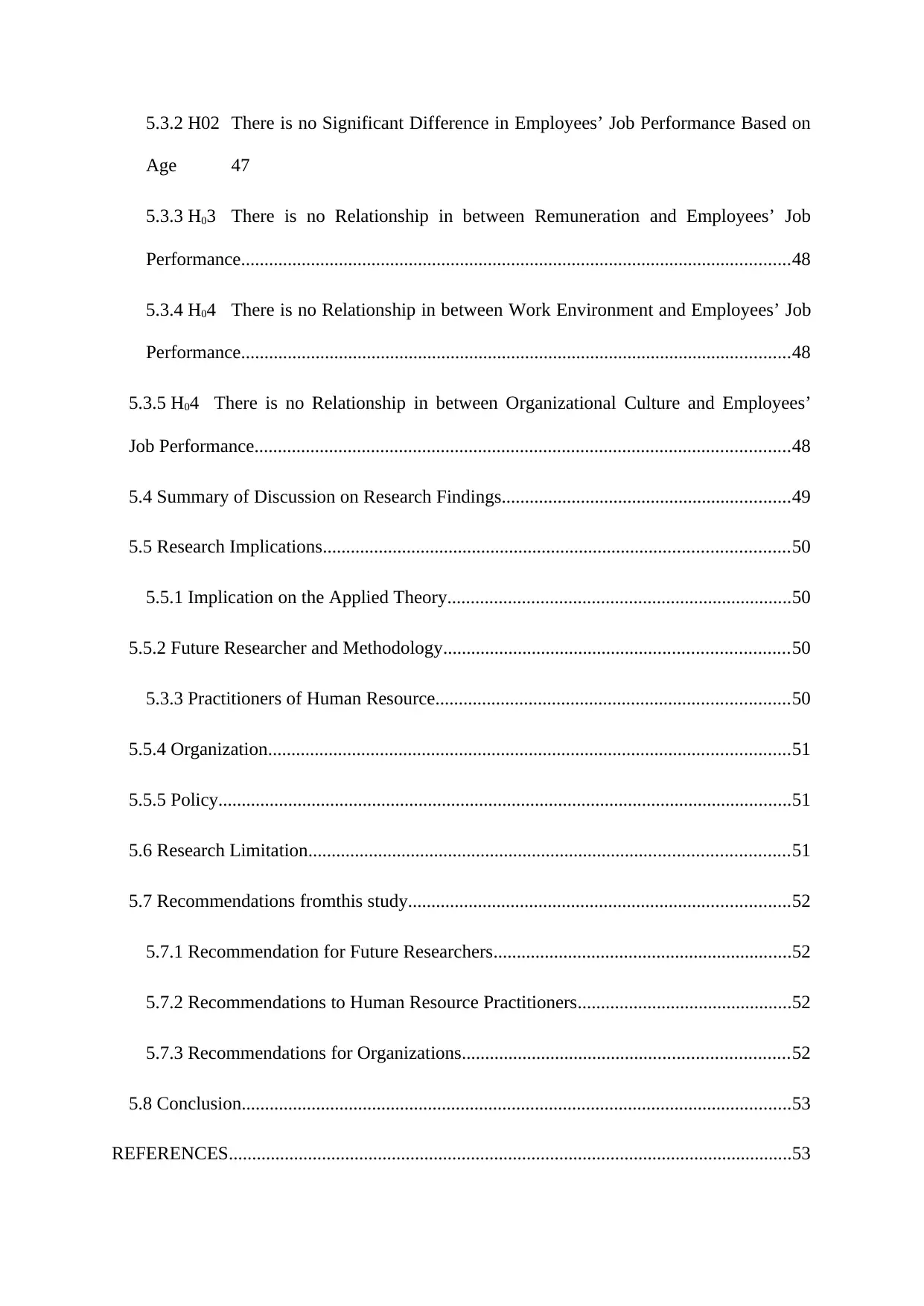
5.3.2 H02 There is no Significant Difference in Employees’ Job Performance Based on
Age 47
5.3.3 H03 There is no Relationship in between Remuneration and Employees’ Job
Performance......................................................................................................................48
5.3.4 H04 There is no Relationship in between Work Environment and Employees’ Job
Performance......................................................................................................................48
5.3.5 H04 There is no Relationship in between Organizational Culture and Employees’
Job Performance...................................................................................................................48
5.4 Summary of Discussion on Research Findings..............................................................49
5.5 Research Implications....................................................................................................50
5.5.1 Implication on the Applied Theory..........................................................................50
5.5.2 Future Researcher and Methodology..........................................................................50
5.3.3 Practitioners of Human Resource............................................................................50
5.5.4 Organization................................................................................................................51
5.5.5 Policy...........................................................................................................................51
5.6 Research Limitation.......................................................................................................51
5.7 Recommendations fromthis study..................................................................................52
5.7.1 Recommendation for Future Researchers................................................................52
5.7.2 Recommendations to Human Resource Practitioners..............................................52
5.7.3 Recommendations for Organizations......................................................................52
5.8 Conclusion......................................................................................................................53
REFERENCES.........................................................................................................................53
Age 47
5.3.3 H03 There is no Relationship in between Remuneration and Employees’ Job
Performance......................................................................................................................48
5.3.4 H04 There is no Relationship in between Work Environment and Employees’ Job
Performance......................................................................................................................48
5.3.5 H04 There is no Relationship in between Organizational Culture and Employees’
Job Performance...................................................................................................................48
5.4 Summary of Discussion on Research Findings..............................................................49
5.5 Research Implications....................................................................................................50
5.5.1 Implication on the Applied Theory..........................................................................50
5.5.2 Future Researcher and Methodology..........................................................................50
5.3.3 Practitioners of Human Resource............................................................................50
5.5.4 Organization................................................................................................................51
5.5.5 Policy...........................................................................................................................51
5.6 Research Limitation.......................................................................................................51
5.7 Recommendations fromthis study..................................................................................52
5.7.1 Recommendation for Future Researchers................................................................52
5.7.2 Recommendations to Human Resource Practitioners..............................................52
5.7.3 Recommendations for Organizations......................................................................52
5.8 Conclusion......................................................................................................................53
REFERENCES.........................................................................................................................53
Paraphrase This Document
Need a fresh take? Get an instant paraphrase of this document with our AI Paraphraser
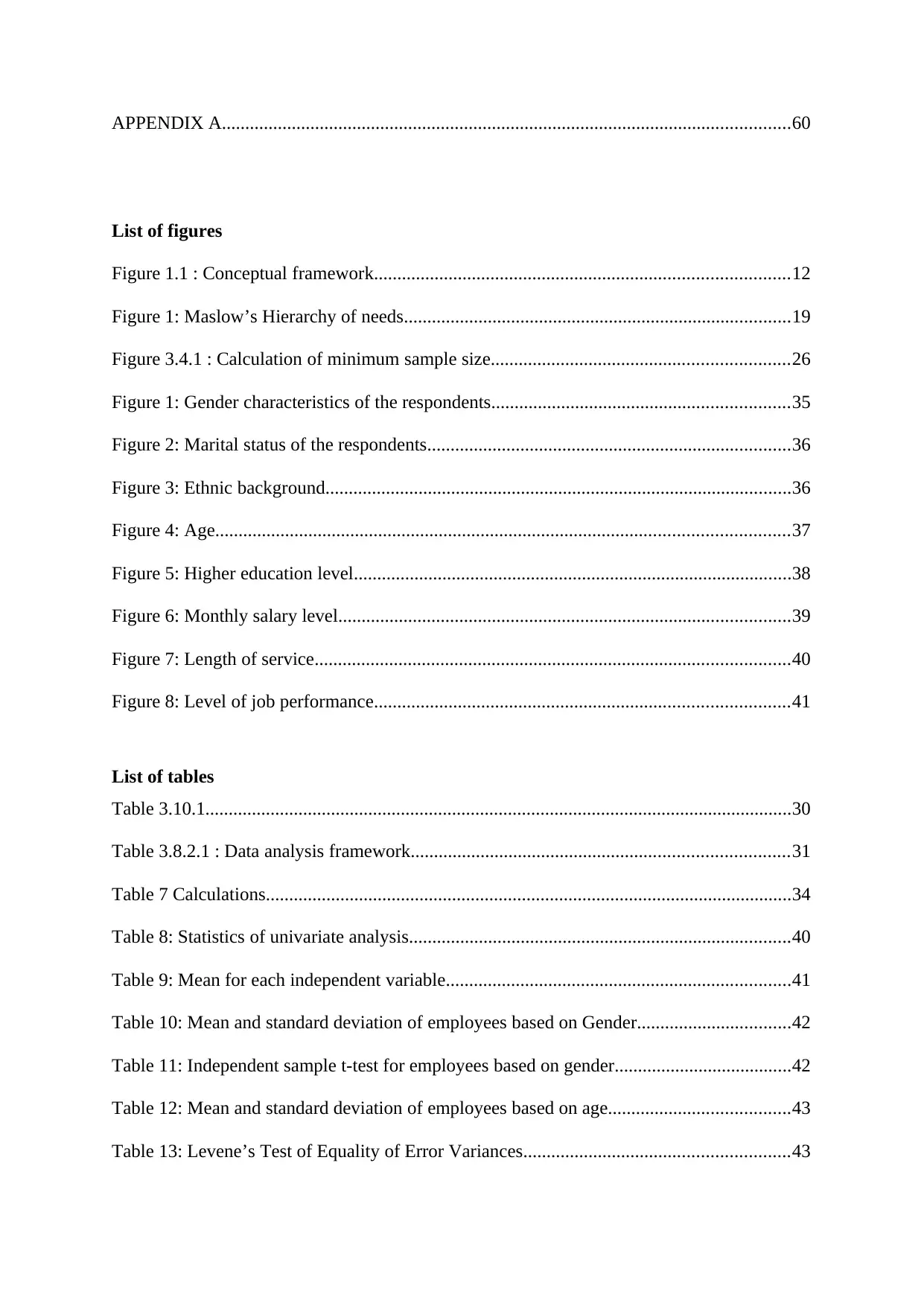
APPENDIX A..........................................................................................................................60
List of figures
Figure 1.1 : Conceptual framework.........................................................................................12
Figure 1: Maslow’s Hierarchy of needs...................................................................................19
Figure 3.4.1 : Calculation of minimum sample size................................................................26
Figure 1: Gender characteristics of the respondents................................................................35
Figure 2: Marital status of the respondents..............................................................................36
Figure 3: Ethnic background....................................................................................................36
Figure 4: Age...........................................................................................................................37
Figure 5: Higher education level..............................................................................................38
Figure 6: Monthly salary level.................................................................................................39
Figure 7: Length of service......................................................................................................40
Figure 8: Level of job performance.........................................................................................41
List of tables
Table 3.10.1..............................................................................................................................30
Table 3.8.2.1 : Data analysis framework.................................................................................31
Table 7 Calculations.................................................................................................................34
Table 8: Statistics of univariate analysis..................................................................................40
Table 9: Mean for each independent variable..........................................................................41
Table 10: Mean and standard deviation of employees based on Gender.................................42
Table 11: Independent sample t-test for employees based on gender......................................42
Table 12: Mean and standard deviation of employees based on age.......................................43
Table 13: Levene’s Test of Equality of Error Variances.........................................................43
List of figures
Figure 1.1 : Conceptual framework.........................................................................................12
Figure 1: Maslow’s Hierarchy of needs...................................................................................19
Figure 3.4.1 : Calculation of minimum sample size................................................................26
Figure 1: Gender characteristics of the respondents................................................................35
Figure 2: Marital status of the respondents..............................................................................36
Figure 3: Ethnic background....................................................................................................36
Figure 4: Age...........................................................................................................................37
Figure 5: Higher education level..............................................................................................38
Figure 6: Monthly salary level.................................................................................................39
Figure 7: Length of service......................................................................................................40
Figure 8: Level of job performance.........................................................................................41
List of tables
Table 3.10.1..............................................................................................................................30
Table 3.8.2.1 : Data analysis framework.................................................................................31
Table 7 Calculations.................................................................................................................34
Table 8: Statistics of univariate analysis..................................................................................40
Table 9: Mean for each independent variable..........................................................................41
Table 10: Mean and standard deviation of employees based on Gender.................................42
Table 11: Independent sample t-test for employees based on gender......................................42
Table 12: Mean and standard deviation of employees based on age.......................................43
Table 13: Levene’s Test of Equality of Error Variances.........................................................43
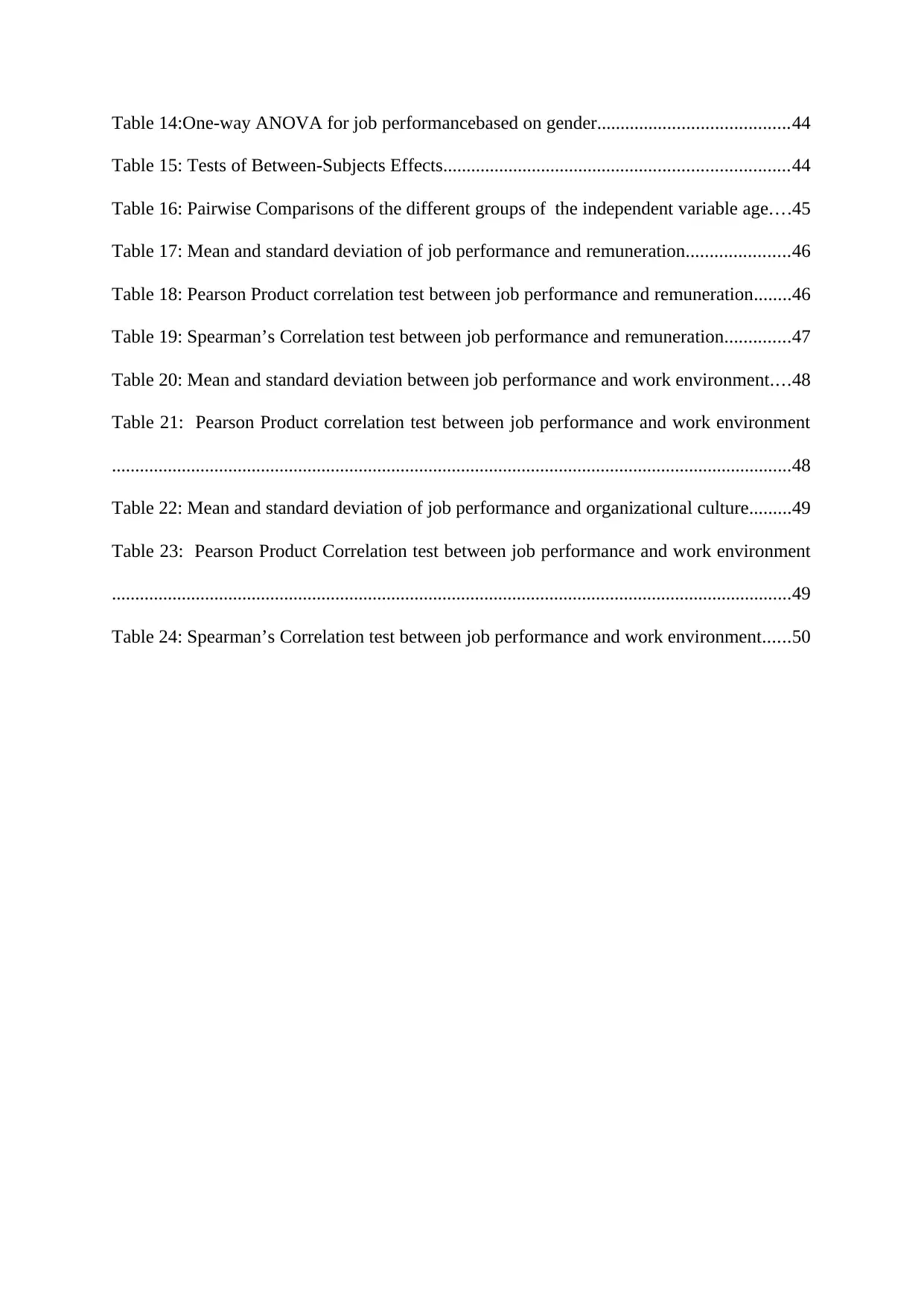
Table 14:One-way ANOVA for job performancebased on gender.........................................44
Table 15: Tests of Between-Subjects Effects..........................................................................44
Table 16: Pairwise Comparisons of the different groups of the independent variable age....45
Table 17: Mean and standard deviation of job performance and remuneration......................46
Table 18: Pearson Product correlation test between job performance and remuneration........46
Table 19: Spearman’s Correlation test between job performance and remuneration..............47
Table 20: Mean and standard deviation between job performance and work environment....48
Table 21: Pearson Product correlation test between job performance and work environment
..................................................................................................................................................48
Table 22: Mean and standard deviation of job performance and organizational culture.........49
Table 23: Pearson Product Correlation test between job performance and work environment
..................................................................................................................................................49
Table 24: Spearman’s Correlation test between job performance and work environment......50
Table 15: Tests of Between-Subjects Effects..........................................................................44
Table 16: Pairwise Comparisons of the different groups of the independent variable age....45
Table 17: Mean and standard deviation of job performance and remuneration......................46
Table 18: Pearson Product correlation test between job performance and remuneration........46
Table 19: Spearman’s Correlation test between job performance and remuneration..............47
Table 20: Mean and standard deviation between job performance and work environment....48
Table 21: Pearson Product correlation test between job performance and work environment
..................................................................................................................................................48
Table 22: Mean and standard deviation of job performance and organizational culture.........49
Table 23: Pearson Product Correlation test between job performance and work environment
..................................................................................................................................................49
Table 24: Spearman’s Correlation test between job performance and work environment......50
⊘ This is a preview!⊘
Do you want full access?
Subscribe today to unlock all pages.

Trusted by 1+ million students worldwide
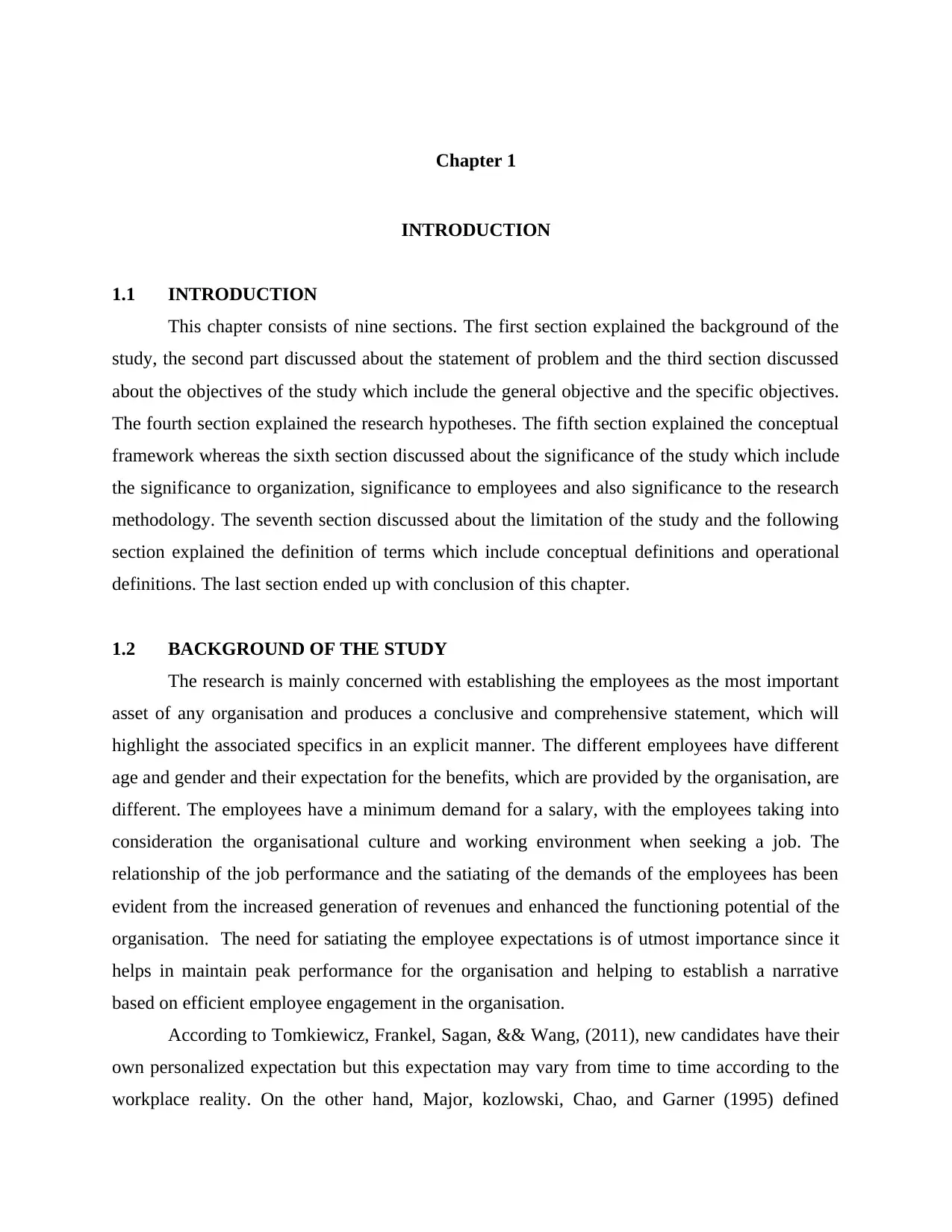
Chapter 1
INTRODUCTION
1.1 INTRODUCTION
This chapter consists of nine sections. The first section explained the background of the
study, the second part discussed about the statement of problem and the third section discussed
about the objectives of the study which include the general objective and the specific objectives.
The fourth section explained the research hypotheses. The fifth section explained the conceptual
framework whereas the sixth section discussed about the significance of the study which include
the significance to organization, significance to employees and also significance to the research
methodology. The seventh section discussed about the limitation of the study and the following
section explained the definition of terms which include conceptual definitions and operational
definitions. The last section ended up with conclusion of this chapter.
1.2 BACKGROUND OF THE STUDY
The research is mainly concerned with establishing the employees as the most important
asset of any organisation and produces a conclusive and comprehensive statement, which will
highlight the associated specifics in an explicit manner. The different employees have different
age and gender and their expectation for the benefits, which are provided by the organisation, are
different. The employees have a minimum demand for a salary, with the employees taking into
consideration the organisational culture and working environment when seeking a job. The
relationship of the job performance and the satiating of the demands of the employees has been
evident from the increased generation of revenues and enhanced the functioning potential of the
organisation. The need for satiating the employee expectations is of utmost importance since it
helps in maintain peak performance for the organisation and helping to establish a narrative
based on efficient employee engagement in the organisation.
According to Tomkiewicz, Frankel, Sagan, && Wang, (2011), new candidates have their
own personalized expectation but this expectation may vary from time to time according to the
workplace reality. On the other hand, Major, kozlowski, Chao, and Garner (1995) defined
INTRODUCTION
1.1 INTRODUCTION
This chapter consists of nine sections. The first section explained the background of the
study, the second part discussed about the statement of problem and the third section discussed
about the objectives of the study which include the general objective and the specific objectives.
The fourth section explained the research hypotheses. The fifth section explained the conceptual
framework whereas the sixth section discussed about the significance of the study which include
the significance to organization, significance to employees and also significance to the research
methodology. The seventh section discussed about the limitation of the study and the following
section explained the definition of terms which include conceptual definitions and operational
definitions. The last section ended up with conclusion of this chapter.
1.2 BACKGROUND OF THE STUDY
The research is mainly concerned with establishing the employees as the most important
asset of any organisation and produces a conclusive and comprehensive statement, which will
highlight the associated specifics in an explicit manner. The different employees have different
age and gender and their expectation for the benefits, which are provided by the organisation, are
different. The employees have a minimum demand for a salary, with the employees taking into
consideration the organisational culture and working environment when seeking a job. The
relationship of the job performance and the satiating of the demands of the employees has been
evident from the increased generation of revenues and enhanced the functioning potential of the
organisation. The need for satiating the employee expectations is of utmost importance since it
helps in maintain peak performance for the organisation and helping to establish a narrative
based on efficient employee engagement in the organisation.
According to Tomkiewicz, Frankel, Sagan, && Wang, (2011), new candidates have their
own personalized expectation but this expectation may vary from time to time according to the
workplace reality. On the other hand, Major, kozlowski, Chao, and Garner (1995) defined
Paraphrase This Document
Need a fresh take? Get an instant paraphrase of this document with our AI Paraphraser
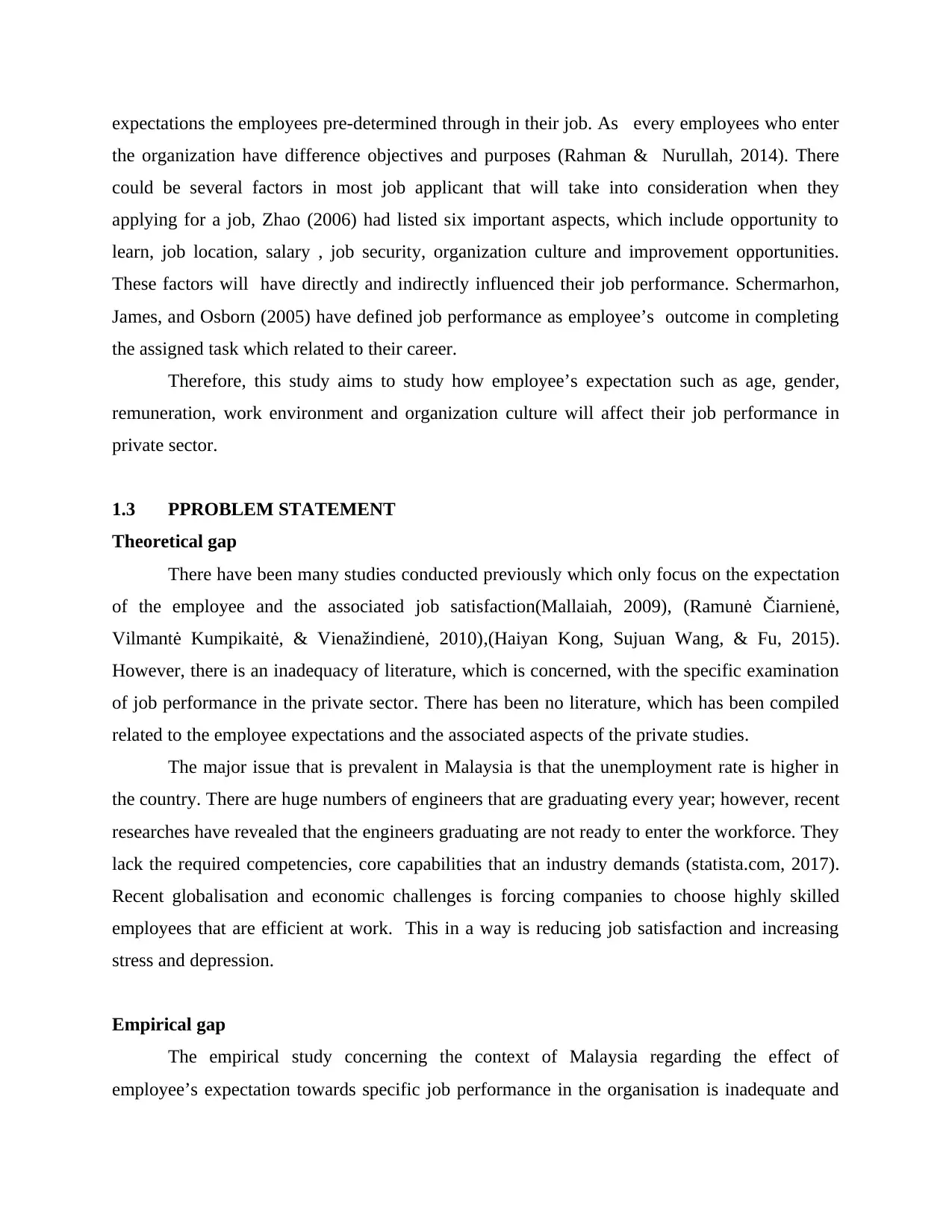
expectations the employees pre-determined through in their job. As every employees who enter
the organization have difference objectives and purposes (Rahman & Nurullah, 2014). There
could be several factors in most job applicant that will take into consideration when they
applying for a job, Zhao (2006) had listed six important aspects, which include opportunity to
learn, job location, salary , job security, organization culture and improvement opportunities.
These factors will have directly and indirectly influenced their job performance. Schermarhon,
James, and Osborn (2005) have defined job performance as employee’s outcome in completing
the assigned task which related to their career.
Therefore, this study aims to study how employee’s expectation such as age, gender,
remuneration, work environment and organization culture will affect their job performance in
private sector.
1.3 PPROBLEM STATEMENT
Theoretical gap
There have been many studies conducted previously which only focus on the expectation
of the employee and the associated job satisfaction(Mallaiah, 2009), (Ramunė Č iarnienė,
Vilmantė Kumpikaitė, & Vienažindienė, 2010) ,(Haiyan Kong, Sujuan Wang, & Fu, 2015).
However, there is an inadequacy of literature, which is concerned, with the specific examination
of job performance in the private sector. There has been no literature, which has been compiled
related to the employee expectations and the associated aspects of the private studies.
The major issue that is prevalent in Malaysia is that the unemployment rate is higher in
the country. There are huge numbers of engineers that are graduating every year; however, recent
researches have revealed that the engineers graduating are not ready to enter the workforce. They
lack the required competencies, core capabilities that an industry demands (statista.com, 2017).
Recent globalisation and economic challenges is forcing companies to choose highly skilled
employees that are efficient at work. This in a way is reducing job satisfaction and increasing
stress and depression.
Empirical gap
The empirical study concerning the context of Malaysia regarding the effect of
employee’s expectation towards specific job performance in the organisation is inadequate and
the organization have difference objectives and purposes (Rahman & Nurullah, 2014). There
could be several factors in most job applicant that will take into consideration when they
applying for a job, Zhao (2006) had listed six important aspects, which include opportunity to
learn, job location, salary , job security, organization culture and improvement opportunities.
These factors will have directly and indirectly influenced their job performance. Schermarhon,
James, and Osborn (2005) have defined job performance as employee’s outcome in completing
the assigned task which related to their career.
Therefore, this study aims to study how employee’s expectation such as age, gender,
remuneration, work environment and organization culture will affect their job performance in
private sector.
1.3 PPROBLEM STATEMENT
Theoretical gap
There have been many studies conducted previously which only focus on the expectation
of the employee and the associated job satisfaction(Mallaiah, 2009), (Ramunė Č iarnienė,
Vilmantė Kumpikaitė, & Vienažindienė, 2010) ,(Haiyan Kong, Sujuan Wang, & Fu, 2015).
However, there is an inadequacy of literature, which is concerned, with the specific examination
of job performance in the private sector. There has been no literature, which has been compiled
related to the employee expectations and the associated aspects of the private studies.
The major issue that is prevalent in Malaysia is that the unemployment rate is higher in
the country. There are huge numbers of engineers that are graduating every year; however, recent
researches have revealed that the engineers graduating are not ready to enter the workforce. They
lack the required competencies, core capabilities that an industry demands (statista.com, 2017).
Recent globalisation and economic challenges is forcing companies to choose highly skilled
employees that are efficient at work. This in a way is reducing job satisfaction and increasing
stress and depression.
Empirical gap
The empirical study concerning the context of Malaysia regarding the effect of
employee’s expectation towards specific job performance in the organisation is inadequate and

no detailed research literature is available. The previous literature concerning the same research
has been conducted pertaining to the banking industry and the academic institutions, which were
conducted in United Kingdom (Broadbridge, G. Maxwell, & Ogden, 2007) and Canada(Krahn &
Galambos, 2014).. There has been no analysis regarding the research of the relationship in
between the job performance and the expectation of employees in the private sector, hence this
domain of study is unacknowledged (Wayne et al., 2017). The previous literature, which has
been conceived pertaining to this specific subject matter, is vague and inadequate. There are
comparative studies of public and private sector employees, however the research related to the
employee expectation for private employee specific in Malaysia is severely lacking.
On the other hand, according to the research done by Randstad Sdn Bhd (Randstad is one
of the leading staffing agencies in Malaysia), almost seven in 10 employees and job seekers in
Malaysia said that ‘attractive salary and benefits’ is the number one must-have criteria for their
ideal employer. Then followed by work - life balance whichabout 49 per cent and career
progression is about 40 per cent. Therefor employees’ expectations of having an attractive salary
and benefits have increased by five (5) per cent on year 2018 from 63% in year 2017. This
upward trend suggests that employees and job seekers in Malaysia might be prioritising salary to
meet the higher cost of living and as a security buffer due to the potential uncertainties around
the local economic and political landscape.(RANDSTAD, 2018)
Therefore, the researcher is interested in investigating the relationship between the
employee’s expectation and job performance in Malaysia especially in private sector as
researcher will chose few factors such as age, gender, remuneration, work environment and
organisation as expected of employees. This shalldiscuss in order to determine influent factor
toward employees job performance.
1.4 OBJECTIVE OF STUDY
The objectives of a research project summarize what is needed to be achieved by the
study (Ahmad & Usop, 2011). Hence, the objectives of this study are divided into two
categories, namely general objectives and specific objectives.
1.4.1 General Objective
has been conducted pertaining to the banking industry and the academic institutions, which were
conducted in United Kingdom (Broadbridge, G. Maxwell, & Ogden, 2007) and Canada(Krahn &
Galambos, 2014).. There has been no analysis regarding the research of the relationship in
between the job performance and the expectation of employees in the private sector, hence this
domain of study is unacknowledged (Wayne et al., 2017). The previous literature, which has
been conceived pertaining to this specific subject matter, is vague and inadequate. There are
comparative studies of public and private sector employees, however the research related to the
employee expectation for private employee specific in Malaysia is severely lacking.
On the other hand, according to the research done by Randstad Sdn Bhd (Randstad is one
of the leading staffing agencies in Malaysia), almost seven in 10 employees and job seekers in
Malaysia said that ‘attractive salary and benefits’ is the number one must-have criteria for their
ideal employer. Then followed by work - life balance whichabout 49 per cent and career
progression is about 40 per cent. Therefor employees’ expectations of having an attractive salary
and benefits have increased by five (5) per cent on year 2018 from 63% in year 2017. This
upward trend suggests that employees and job seekers in Malaysia might be prioritising salary to
meet the higher cost of living and as a security buffer due to the potential uncertainties around
the local economic and political landscape.(RANDSTAD, 2018)
Therefore, the researcher is interested in investigating the relationship between the
employee’s expectation and job performance in Malaysia especially in private sector as
researcher will chose few factors such as age, gender, remuneration, work environment and
organisation as expected of employees. This shalldiscuss in order to determine influent factor
toward employees job performance.
1.4 OBJECTIVE OF STUDY
The objectives of a research project summarize what is needed to be achieved by the
study (Ahmad & Usop, 2011). Hence, the objectives of this study are divided into two
categories, namely general objectives and specific objectives.
1.4.1 General Objective
⊘ This is a preview!⊘
Do you want full access?
Subscribe today to unlock all pages.

Trusted by 1+ million students worldwide
1 out of 73
Related Documents
Your All-in-One AI-Powered Toolkit for Academic Success.
+13062052269
info@desklib.com
Available 24*7 on WhatsApp / Email
![[object Object]](/_next/static/media/star-bottom.7253800d.svg)
Unlock your academic potential
Copyright © 2020–2025 A2Z Services. All Rights Reserved. Developed and managed by ZUCOL.





